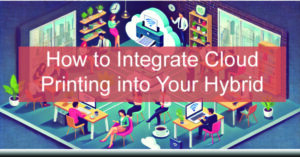How to Integrate Cloud Printing into Your Hybrid Office Environment
Hybrid work isn’t just a trend — it’s the new standard. And as Colorado businesses continue adapting to the evolving landscape of in-office, remote, and mobile work, their office technology needs to evolve, too. At the heart of this transformation? Cloud printing — a secure, flexible, and scalable solution designed for the modern workplace.
Gone are the days of being tethered to a single workstation or VPN connection just to print a document. In 2025, cloud-based printing empowers employees to print securely from anywhere — whether they’re working at home in Highlands Ranch, on the road in Colorado Springs, or from a co-working space in downtown Denver.
In this guide, we’ll walk you through exactly how to integrate cloud printing into your hybrid office environment, step by step. Whether you’re a growing startup or a large organization, these insights will help you modernize your print infrastructure, support your team, and reduce unnecessary IT overhead.
🔍 What Is Cloud Printing?
At its core, cloud printing allows users to send print jobs to a printer over the internet, rather than through traditional local network connections. That means your documents can be sent to any authorized printer — securely and wirelessly — from virtually any device.
Instead of relying on device-specific drivers or clunky server setups, cloud printing works by routing print jobs through a secure cloud-based platform, often integrated with your existing productivity tools (like Google Workspace or Microsoft 365).
In hybrid work models, where employees are distributed across various locations, this level of flexibility and access control is essential.
✅ Step 1: Evaluate Your Current Printing Infrastructure
Before diving into cloud printing, take stock of what you currently have. A quick audit of your print environment helps identify what’s working, what’s outdated, and what can be upgraded or integrated.
Questions to Ask:
-
Are your current printers cloud-compatible (or upgradable)?
-
Do you have a centralized print management system?
-
How are remote employees currently handling print tasks?
-
Are print jobs secure and trackable?
You may find that your fleet of devices from Canon, HP, Kyocera, Epson, or Xerox already supports cloud functionality — especially with firmware updates or add-on software.
🔧 Pro Tip: ABT offers free print assessments for Colorado businesses to help you map out your readiness for cloud printing.
✅ Step 2: Choose the Right Cloud Print Platform
There are several leading cloud printing platforms available, and the best choice depends on your size, existing software stack, and security needs.
Popular Cloud Print Solutions in 2025:
-
HP Wolf for Business – Built-in security and easy fleet management
-
PaperCut Hive – Cloud-native with eco-friendly analytics
-
Canon uniFLOW Online – Great for mixed device environments
-
Xerox Workplace Cloud – Comprehensive remote access and control
-
Google Cloud Print Alternatives – Many third-party solutions now fill this gap
Look for platforms that offer:
-
User authentication and print release
-
Multi-device compatibility
-
Mobile printing support
-
Print analytics and reporting
-
Secure job storage (hold-and-release printing)
🔐 Security is non-negotiable. Make sure your solution includes encryption, role-based access control, and audit trails — especially if your business handles sensitive data.
✅ Step 3: Connect Printers to the Cloud
This is where things get exciting. Depending on your hardware, you’ll either enable cloud features directly on your device or through a print server/client application.
Setup Options:
-
Direct-to-cloud: Modern printers connect to your chosen platform without a physical server.
-
Connector or client apps: Lightweight software installed on one or more devices to route jobs through the cloud securely.
Most platforms walk you through the connection process. Once set up, users can send print jobs from their phones, tablets, or laptops — even if they’re not on the office Wi-Fi.
💡 Many newer printers from brands like Kyocera and HP come cloud-ready. If yours doesn’t, ABT can help you bridge the gap with affordable upgrades.
✅ Step 4: Set Up User Access and Authentication
Managing a hybrid team means you need tight control over who can print, from where, and how often. With cloud printing, this becomes easier — and smarter.
Best Practices:
-
Assign user roles (e.g., employee, manager, admin)
-
Use Single Sign-On (SSO) with platforms like Azure AD or Google Workspace
-
Enable mobile badge or PIN-based release for sensitive prints
-
Group users by department for usage tracking
Not only does this ensure security, but it also helps you track print usage per employee, team, or device, so you can fine-tune policies or reduce unnecessary output.
✅ Step 5: Train Your Team and Roll Out Gradually
Rolling out cloud printing doesn’t have to be disruptive. In fact, most employees will appreciate the added convenience — but some will need guidance.
Employee Training Checklist:
-
How to send print jobs from their devices
-
How to authenticate and retrieve print jobs securely
-
How to troubleshoot common issues (connectivity, login, etc.)
-
Best practices for eco-friendly printing
Consider launching in phases — start with one team or location, gather feedback, and then expand.
🎯 Bonus: Include cloud printing training in your new hire onboarding process so that everyone’s aligned moving forward.
✅ Step 6: Monitor, Optimize, and Support
Once live, it’s important to monitor your print environment to catch inefficiencies or issues early. Most cloud printing platforms come with built-in dashboards and alerts to help with this.
What to Monitor:
-
Total print volumes (daily, weekly, monthly)
-
Peak usage times
-
Frequent error types or failed jobs
-
Supply levels (toner, paper)
Use this data to:
-
Optimize workflows
-
Reduce waste
-
Improve device placement
-
Plan future upgrades
Need help? This is where Managed Print Services (MPS) come in. ABT can remotely manage your entire print infrastructure — from supply restocking to performance optimization — so you can focus on running your business.
💡 Why Cloud Printing Is a Game-Changer for Colorado Businesses
Colorado’s workforce is incredibly dynamic — from fast-growing startups in Boulder to remote-heavy companies in Telluride. Cloud printing meets these unique needs head-on:
Benefits for Colorado Workplaces:
-
🌄 Geographic flexibility – Print from anywhere in the state or beyond
-
🔒 Improved security – Critical for healthcare, finance, legal, and government
-
🌱 Sustainability – Reduce waste with smart print policies
-
💼 Scalability – Add or remove users/devices as your team grows
-
💸 Cost control – Visibility into usage helps you reduce spend
Whether you’re managing a single office or a multi-site organization across Colorado, cloud printing ensures that location is no longer a limitation.
👣 Next Steps: Ready to Make the Move?
Integrating cloud printing doesn’t require an IT overhaul — just a smart plan, the right technology, and a trusted partner to guide you through it.
At ABT, we help Colorado businesses simplify the transition with:
-
Tailored print assessments
-
Vendor-neutral platform recommendations
-
Device upgrades or integrations
-
Ongoing support and Managed Print Services
📞 Let’s Get You Cloud-Ready
Want to know if your business is ready for cloud printing? We’ll walk through your current setup, identify opportunities, and help you create a rollout plan that fits your budget and goals.
👉 Book a free consultation with ABT today and take the first step toward smarter, more flexible printing for your hybrid team.


